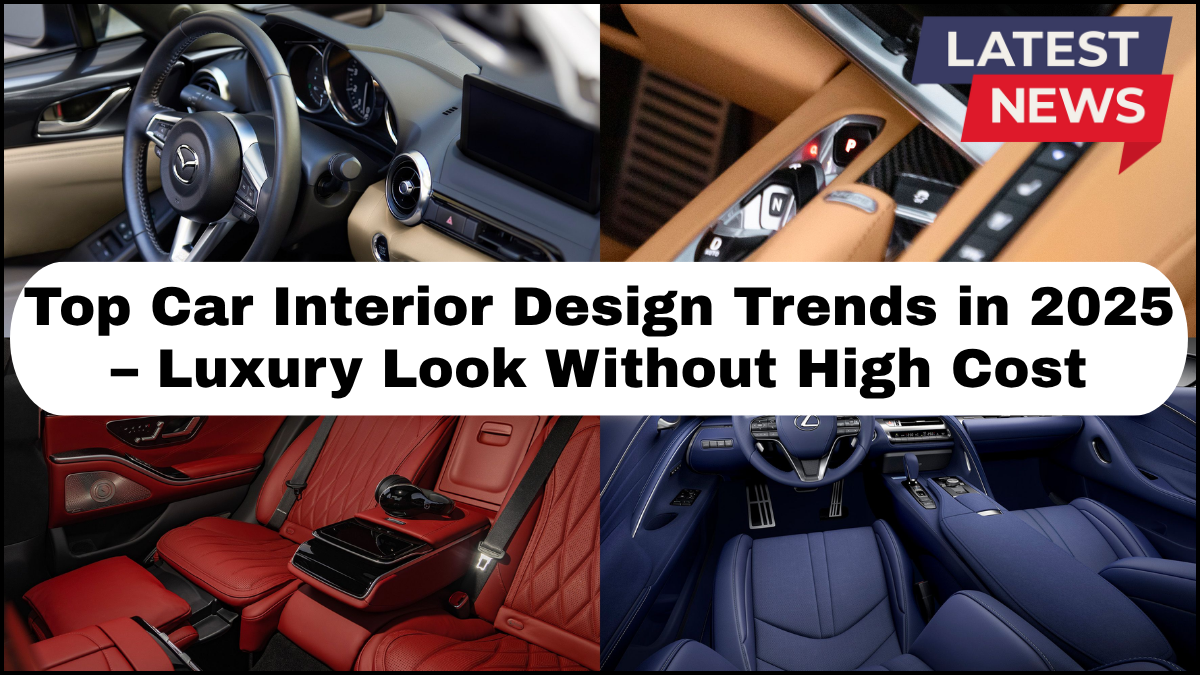The year 2025 is reshaping how we view car interiors. No longer just functional spaces, interiors are becoming statements of style, comfort, and innovation. The best part? You no longer need a six-figure car to enjoy premium design. Thanks to new technologies and smarter materials, car interior trends in 2025 are offering luxury features at affordable prices. Here’s a look at the top trends redefining automotive interiors this year.

Sustainable Yet Sophisticated Materials
Eco-friendly design is no longer an afterthought. In 2025, automakers are using recycled and bio-based materials that rival the look and feel of high-end options. Expect to see interiors made from plant-based leathers, recycled plastics, bamboo trims, and cork accents.
These materials not only reduce environmental impact but also create a modern, upscale appearance. For example, many electric vehicles now feature vegan leather with micro-perforations that improve comfort while mimicking the softness of premium hides.
Ambient Lighting That Elevates Mood
Ambient lighting is becoming a staple of luxury vehicles, but in 2025, even budget-friendly cars are getting this glow-up. Customizable LED lighting strips now run across dashboards, doors, and footwells, allowing drivers to change the cabin’s vibe with a tap.
Some models even sync the lighting with music or drive modes—calming blue for cruising, fiery red for sport. It’s an inexpensive way to add drama and a premium feel, giving buyers a taste of luxury features at affordable price points.
Panoramic Tech Displays
The traditional instrument panel is giving way to wide, seamless screens that stretch across the dashboard. Touch interfaces, voice control, and real-time connectivity define the driving experience in 2025. Expect integrated infotainment systems with AI-powered personal assistants and multi-display dashboards that rival those in high-end sedans.
What makes this trend affordable now is the trickle-down effect: manufacturers are implementing cost-effective versions of these tech setups in compact and mid-range vehicles.
Multi-Texture Dashboards
Uniformity is out. In 2025, dashboards mix textures and materials—think soft-touch suede next to brushed aluminum, or matte finishes with contrast stitching. This design language adds visual interest without requiring expensive materials.
These multi-texture interiors mimic the look of designer vehicles, making entry-level models feel far more refined. It’s a subtle but impactful trend that elevates the cabin without increasing production costs.
Compact Luxury Seating
Gone are the days when plush seating was limited to premium SUVs. Now, even hatchbacks offer quilted stitching, contrast piping, and ergonomic contours. Heated and ventilated seats, memory foam padding, and massage functions are showing up in lower trims.
Some automakers are even using modular seat designs that adapt to posture and pressure points, a feature once exclusive to luxury sedans. It’s part of a broader push to democratize comfort and bring luxury features at affordable levels.
Minimalist Consoles with Hidden Storage
Clutter-free design dominates 2025 interiors. Floating center consoles, retractable cupholders, and hidden storage compartments provide a clean aesthetic while maximizing functionality.
Minimalist design doesn’t just look high-end—it also makes smaller cabins feel more spacious and premium. This trend aligns perfectly with the growing demand for efficiency and elegance in everyday vehicles.
Personalization Options
Customization is no longer a premium privilege. In 2025, buyers can personalize trim colors, seat materials, stitching, ambient light patterns, and even dashboard animations without hefty price tags.
Automakers use modular interior platforms to keep manufacturing costs low while offering customers a tailored experience. The result? A cabin that feels bespoke without the bespoke price.
AI and Smart Integration
Artificial intelligence is powering smart interiors that learn and adapt to your preferences. From auto-adjusting climate zones to personalized driving profiles, AI enhances comfort in ways that feel intuitive and refined.
These systems are now available in more affordable models, driven by scalable technology. It’s a leap in convenience that doesn’t come with luxury-level costs.
FAQs: Car Interior Trends 2025
Q1: What are the top car interior trends in 2025?
A: Major trends include sustainable materials, ambient lighting, panoramic tech displays, personalized interiors, and minimalist design. All of these bring a luxury feel without the high price tag.
Q2: Are these luxury features affordable in entry-level cars?
A: Yes. Thanks to material innovation and scalable tech, features like ambient lighting, AI integration, and ergonomic seats are now common in compact and mid-range vehicles.
Q3: Is ambient lighting just aesthetic or does it serve a function?
A: While ambient lighting enhances style, it also improves visibility, reduces eye strain, and enhances the driving experience during night-time drives.
Q4: How are automakers making sustainable interiors luxurious?
A: By using recycled materials that mimic traditional luxury surfaces, such as vegan leather or bamboo trim, without compromising on style or feel.
Q5: Will AI in car interiors require internet connectivity?
A: Basic AI functions like seat memory and climate control often work offline, but cloud-connected features (like voice assistants) may require internet access.
click here to learn more
